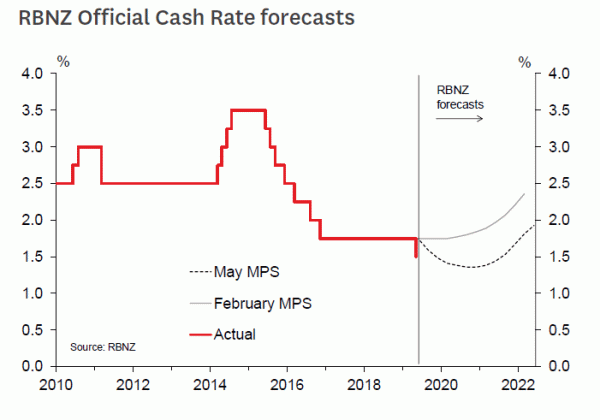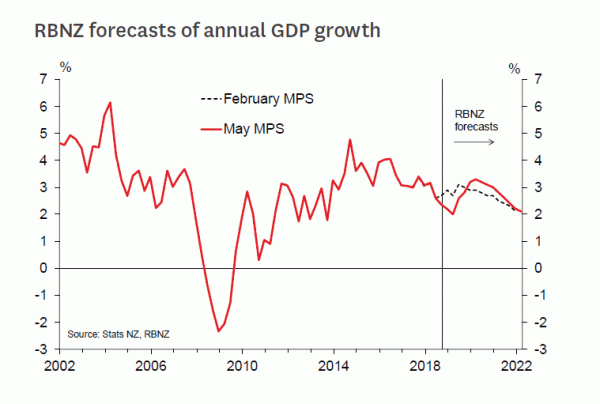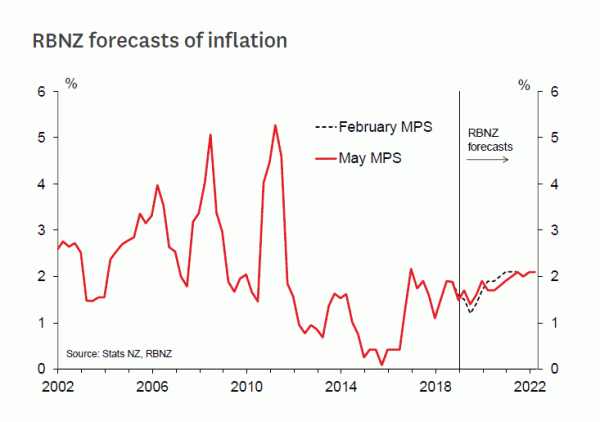- The RBNZ reduced the OCR to 1.5%.
- The RBNZ still has an easing bias. Whether another OCR occurs will depend on the data.
- We think the probability of another OCR cut in June or August is low. There is more risk of another cut in late 2019.
- Today’s OCR cut will cause mortgage rates to fall even further.
- We expect house price inflation to accelerate to 7% p.a. by mid-2020 due to low mortgage rates and the cancellation of capital gains tax
The Reserve Bank today reduced the OCR to a new record low of 1.5%.
The RBNZ’s rationale for cutting the OCR was very much in line with what we expected. Inflation is currently a little below the 2% mid-point of the target range. The RBNZ was previously relying on a pickup in the domestic economy to ensure that inflation returns to target. But that simply has not happened – the economy has slowed instead of accelerating. On top of that, the RBNZ is concerned about a downturn in the global economy.
We more or less agree with the RBNZ’s reasoning – there was more danger of inflation undershooting 2% than there was of inflation spiralling above 2%.
Where to next?
The RBNZ’s communications today indicate that it is not currently planning a follow-up OCR cut, but it is open to the idea if required by the data:
The press release consisted of a justification for cutting the OCR today – there was nothing at all in the press release to indicate what the RBNZ is thinking about future OCR moves.
The RBNZ’s OCR forecast fell to 1.36% by mid-2020. That implies roughly a 50% chance of a second OCR cut over the coming year.
The record of the Monetary Policy Committee meeting showed that the committee thought that cutting the OCR now would “establish a more balanced outlook for interest rates.” In other words, once the OCR was reduced to 1.5%, it was not clear whether a further OCR reduction would be required or not.
During the press conference the Governor reiterated the balanced outlook and said, “we are now in a position to absorb the data.”
Our interpretation of all this is that a further OCR reduction would require the RBNZ to be surprised on the downside by economic developments – even if only a little.
But the RBNZ is already braced for weak data. As it happens, the RBNZ’s near-term forecasts are very much in line with our own. It expects GDP growth to remain subdued at just 0.4% for the March quarter, inflation to remain below 2% this year, and a slightly weaker unemployment rate.
With those subdued forecasts in mind, we don’t see much scope for the RBNZ to be surprised on the downside over the next few months.
Consequently, we regard the odds of a June OCR cut as low, and even an August cut seems unlikely at present. Longer run, the RBNZ is expecting GDP growth to accelerate rapidly, rising back above 3% annual GDP growth. The RBNZ expects one driver of that to be a perkier housing market – the RBNZ is forecasting an acceleration in house price inflation to around 5%, from the current 2.3%. Despite this, the RBNZ expects inflation to only slowly rise, surpassing 2% only in 2021.
Again, we agree with most of the RBNZ’s assessment, with one caveat – we think the boost to the housing market will be bigger. There has been a very large reduction in fixed mortgage rates over the past month. Following today’s OCR cut floating mortgage rates are going to fall, and there could be another round of reductions in fixed rates. Our view is that house price inflation will accelerate to something more like 7% per annum, and the housing market upturn will last longer than the RBNZ is forecasting. This view is not only based on low mortgage rates – the fact that the threat of a capital gains tax has disappeared is another reason to expect a housing market upturn.
According to the record of the MPC meeting, some members of the committee shared our concern that the housing market upturn could be larger than the RBNZ is forecasting.
On the global front, the RBNZ is expecting global economic growth to stabilise thanks to the large reduction in global interest rates that has occurred recently. Despite that, the RBNZ is expecting both oil prices and global prices for New Zealand export commodities, such as dairy, to fall (the rationale being supply dynamics). Once again, we broadly agree with the RBNZ’s views on the global economy.
Given that the RBNZ’s economic views are mostly similar to our own, we have to take them at face value on the OCR outlook – we see a risk of an OCR cut late this year, but it is not definite.
The forecast we issued on 3 April had the OCR falling to 1.5% today, remaining at 1.5% throughout 2019, but falling again to 1.25% in mid-2020. We are now rethinking that. An OCR cut is more likely to happen this year, or not at all. Because capital gains tax has been cancelled, we now think the housing market will be too strong in 2020 to warrant an OCR cut at that time. Over the coming couple of weeks we will ponder the question of whether or not the OCR will be reduced to 1.25% later this year, and update our OCR forecast accordingly.















